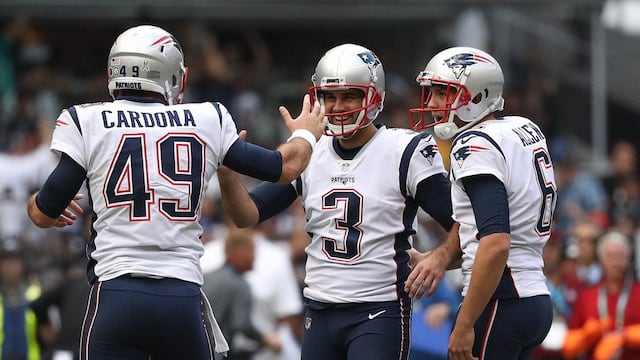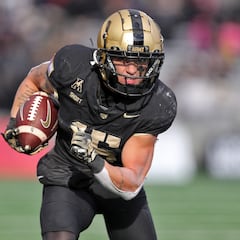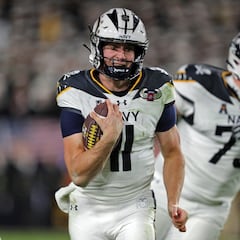We take a look at what happens when the NFL wants a player but Uncle Sam already holds their papers. How does the NFL treat a prospective draft pick?

Has anyone from Army or Navy ever been drafted to the NFL? College football

Around 73,000 football players participate in an NCAA football program per year, and all of them dream of being drafted by an NFL team. Most are aware that the chances are slim, especially at the smaller colleges in the lower divisions. But there is always a chance that you will get the call. Terry Bradshaw was a star at previously independent Louisiana Tech, Jerry Rice came out of Mississippi Valley State and more recently Tyreek Hill was picked up from Division II University of West Alabama.
There are five federal service colleges representing all three military branches, Army, Navy, and Air Force. The Army-Navy game is one of the great American annual events, drawing interest from both within and beyond the normal football fan base. Much like the Kentucky Derby or the New York Marathon, it is seen as a tradition within its own right.
Your Need to Know heading into kickoff on Saturday!#GoArmy x #BeatNavy pic.twitter.com/xBUfcHzVRY
— Army Football (@ArmyWP_Football) December 10, 2025
NCAA football is extremely popular with fans, possibly even more popular than the NFL. Part of this is to do with the sheer number of schools that compete, allowing a much more local feel to the games than a 32-team NFL can. But another of the factors in the interest in watching these games is in seeing tomorrow’s stars before they get drafted. In that element, however, there is something amiss when we fawn over the players on the field during the Army-Navy game. They have already signed papers committing to a career in the military.
Apart from the explicitly military academies, there are six university programs in the country that are considered “senior military colleges” offering Reserve Officers’ Training Corps (ROTC) programs under Title 10 of the United States Code. Three of these six, Texas A&M, Citadel, and Virginia Tech regularly supply players to the NFL, but students at these colleges are by definition destined for the reserve units of the military. West Point and Annapolis are institutions for already-enlisted military personnel, as is the US Air Force Academy in Colorado Springs as well. Their graduates are required to serve on active duty in their branch when they graduate.
Despite this restriction to a future in the NFL, there has been a long tradition of teams choosing to draft exceptional players which dates back to the early days of the game. In most cases, there is an understanding that if you draft a military player, they will come to your organization once their military service is finished. In recent years, however, there has been more use of the deferment of service option by both the Army and the Navy to allow players the chance to pursue an NFL career directly after college.
Field paint is looking good 🎨#ArmyNavy pic.twitter.com/QNsbxgsiIp
— Army-Navy Game (@ArmyNavyGame) December 11, 2025
Each branch of the military has their own way of dealing with it, but in all events it is looked at on a case by case basis. The US Army expects that if they allow a player to pursue what they refer to as an Alternative Service Option “cadets will owe two years of active service in the Army, during which time they will be allowed to play their sport in the player-development systems of their respective organizations and be assigned to recruiting stations. If they remain in professional sports following those two years, they will be provided the option of buying out the remaining three years of their active-duty commitment in exchange for six years of reserve time.”
The Secretary of the Navy also has the option of a similar service option, known as a waiver, in which case they would serve as Reservists instead of active duty. There is an argument that the service would benefit more from the publicity of having an NFL academy alumnus than having them serve on active duty, but in times of war or other national need, there tends to be a drop in waivers granted.
In recent years, there have been a few big names that have been drafted by NFL teams, including Bryce Fisher and Chad Hennings from the Air Force, but by far the standout was the Dallas Cowboys picking Roger Staubach from Navy. After serving his four years, including a year in Vietnam, he became the quarterback for the Cowboys and led them to four Super Bowl victories.
Roger Staubach in Vietnam.
— Old Time Football 🏈 (@Ol_TimeFootball) November 11, 2021
He would practice with the #DallasCowboys on his 2 week summer breaks.#VeteransDay #ThankYouForYourService pic.twitter.com/xliB5s6o3a
Navy Midshipmen in the NFL draft
Since 2000, four Navy Midshipmen have been drafted:
- Joe Cardona in 2015 by the New England Patriots
- Keenan Reynolds in 2016 by the Baltimore Ravens
- Malcolm Perry in 2020 by the Miami Dolphins
- Rayuan Lane III in 2025 by the Jacksonville Jaguars
"There's a great degree of satisfaction to be able to suit up on Sundays, obviously knowing that you're representing something bigger than yourself.” – Marine Corps Reserve 2nd Lt. and Jaguars Safety Rayuan Lane III
— Jacksonville Jaguars (@Jaguars) November 12, 2025
(Via Intersport LLC) pic.twitter.com/EZQJuxDx9t
Related stories

Army vs Navy football games: Record and stats

Army vs Navy football game: History and origin
Many more players from these schools will finish their service and then enter free agency, however, as was the case with Alejandro Villanueva from the Army who played for the Steelers from 2014 - 2020 and then ended his career playing for the Baltimore Ravens in the 2021 season.
For the risk that NFL teams will take on perhaps “wasting” a draft pick on someone who may not be able to report to camp, it seems that this will remain the primary route for cadets and ensigns into the NFL.
Complete your personal details to comment